Market Trends - July 2018
2018 YTD: A Wild Ride
for San Francisco Real Estate
for San Francisco Real Estate
Mid-Year 2018 Report
------------------------------------------------------------
------------------------------------------------------------
By any measure, the heat of the San Francisco market in the first half of 2018 has been among the most blistering ever. Probably only 3 or 4 other periods over the past 50 years have seen a comparable intensity of buyer demand vis a vis the supply of listing inventory available to purchase. This despite both significant increases in interest rates and changes in federal tax law severely limiting the deductibility of mortgage interest and property tax costs. As mentioned before, the market is particularly ferocious in the lower and middle-price segments of house sales.
------------------------------------------------------------
Annual Dollar Value Appreciation
Appreciation is typically viewed through the lens of percentage changes, but looking at the actual increase in dollars paid for a median priced home is perhaps more visceral. These two charts below measure dollar increases in annual median sales prices for houses and then condos. The last columns in each chart measure 2018 YTD median sales price increases against the 2017 median sales price.
Comparing the first half of 2018 to 2017, the median house sales price in San Francisco increased by an astounding $205,000 (per sales reported by 7/3/18). For condos, the increase was also very substantial, at about $71,000.
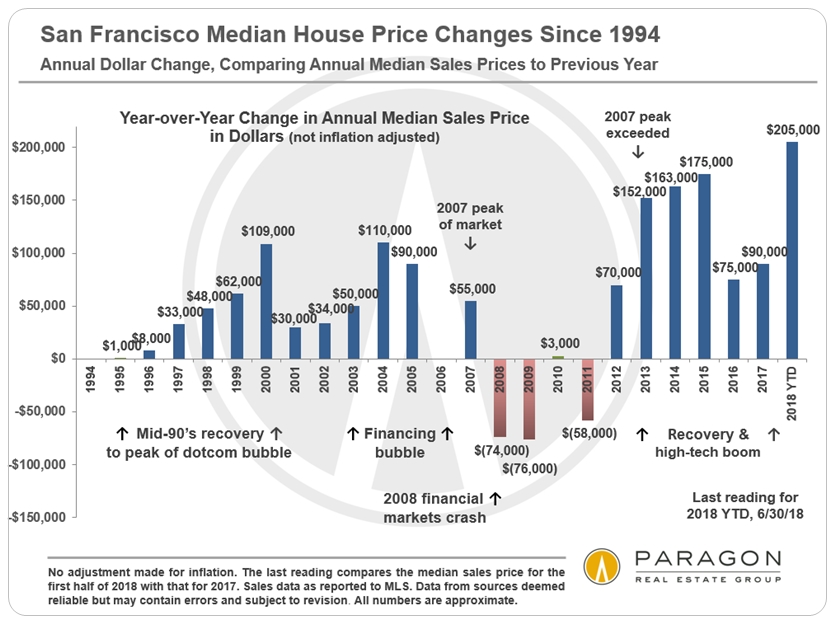
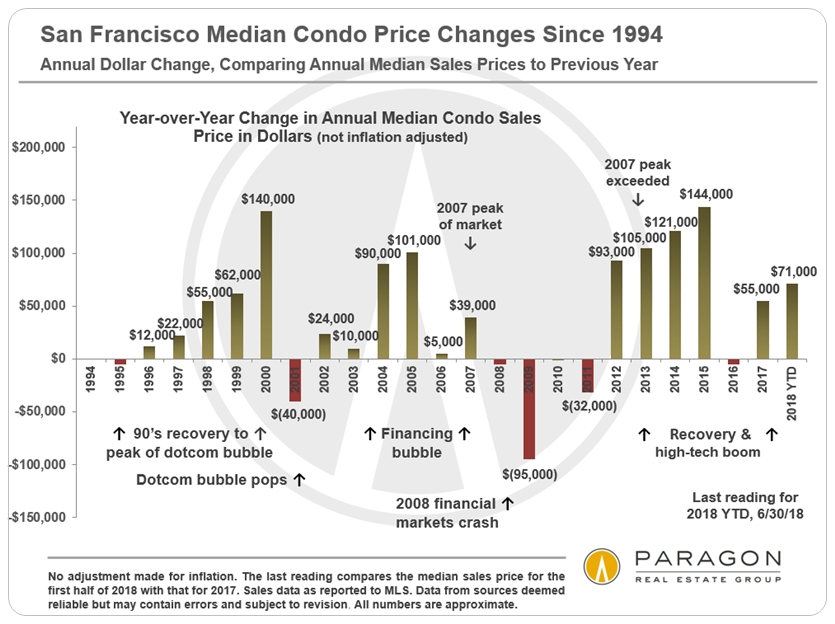
It is not a given that the second half of the year will see home price appreciation at similar rates: Prices could increase further, or they might plateau or even tick down instead. (As can be seen above, home prices can go down as well as up, though longer term trends have always been positive.) For the last 7 years, spring has typically been the most feverish selling season of the year and has often provided most of the appreciation occurring in the full year.
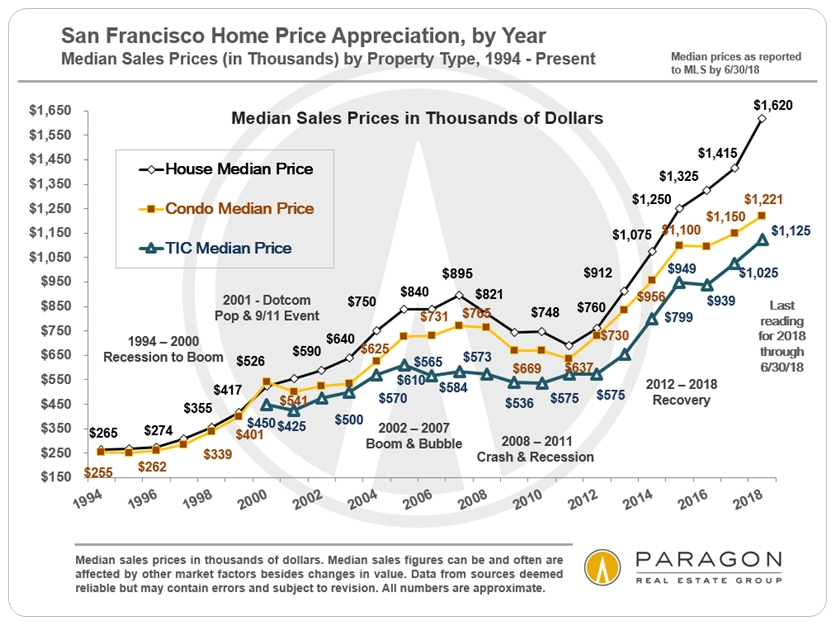
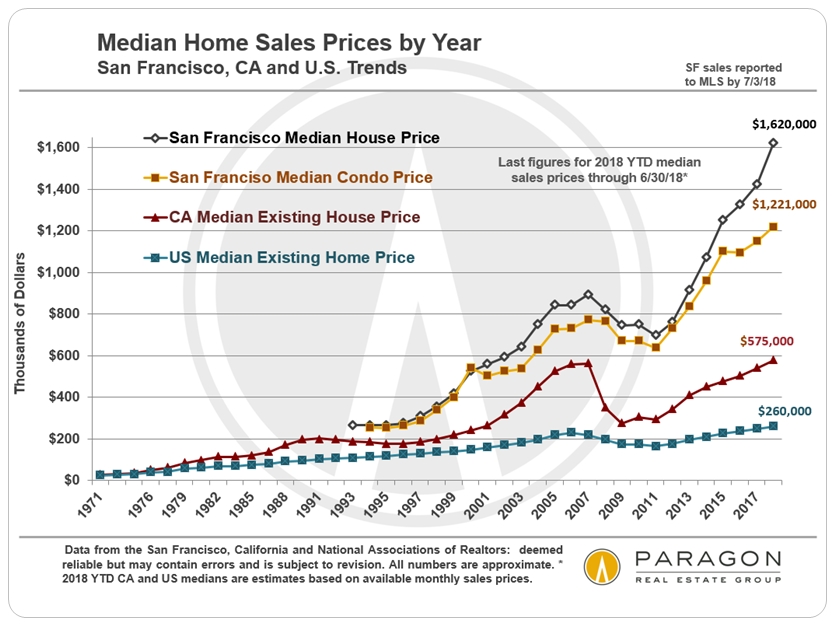
Median sales prices are often affected by other factors besides changes in fair
market value, such as changes in inventory, new home sales or luxury home sales.
------------------------------------------------------------
Market Dynamics Statistics
The decline in new listings, especially of houses, has been
a critical factor in the upward pressure on prices.
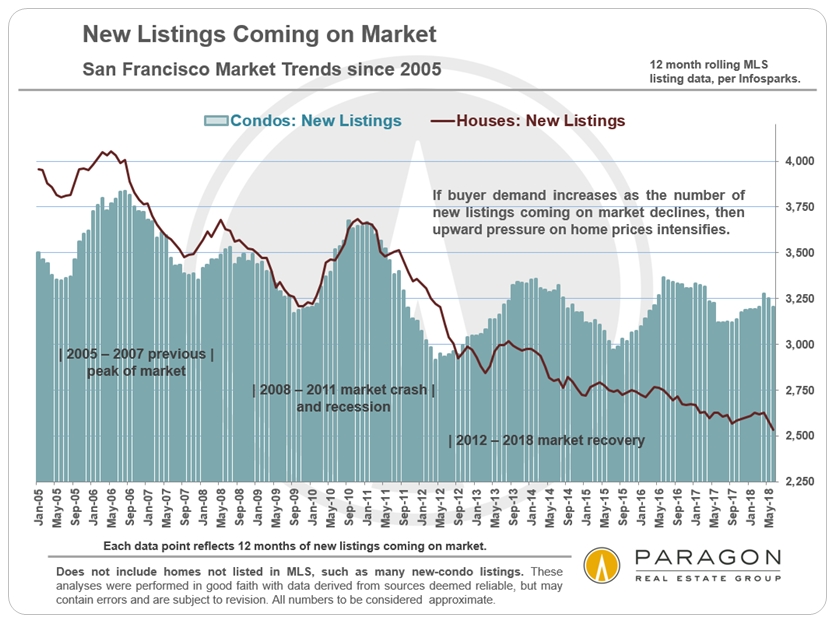
As houses have become the scarce resource in the San Francisco market,
overbidding percentages have gone into the stratosphere (though
strategic underpricing has also played a role).
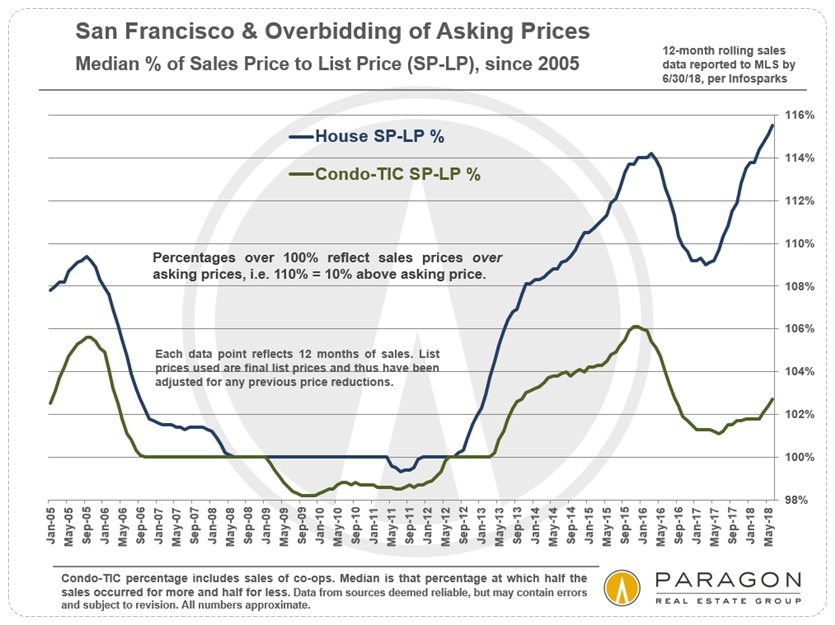
New lows in average days-on-market since the 2012 recovery began:
Listings have been snapped up faster than at any time in the past 7 years.
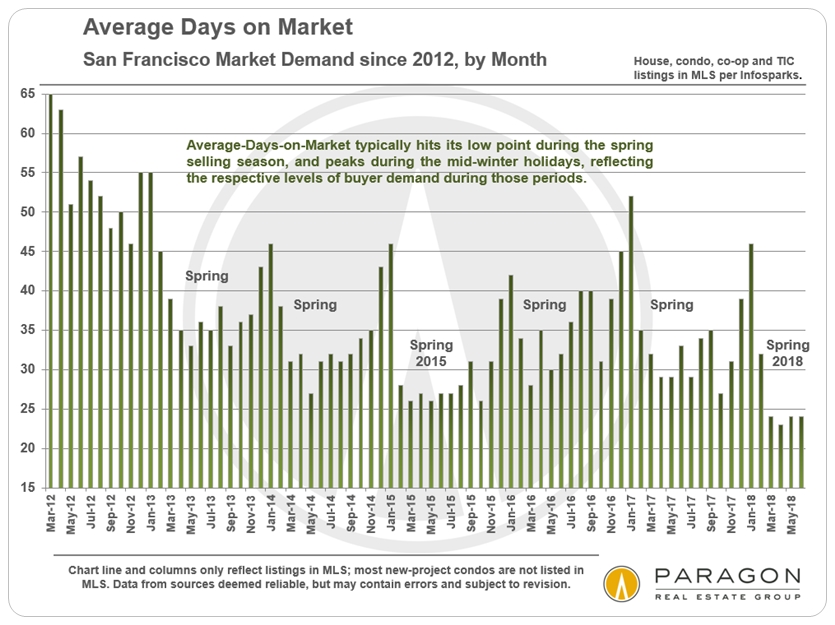
Market activity typically starts slowing significantly in July
before spiking up again in the short autumn selling season.
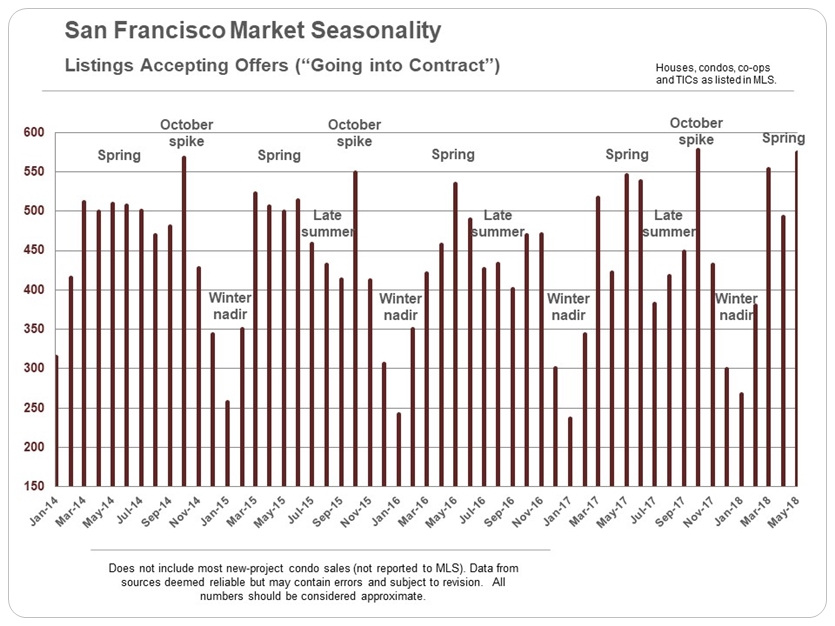
------------------------------------------------------------
San Francisco Luxury Home Sales
as reported to MLS
The second quarter of 2018 saw the highest quarterly number of San Francisco homes selling for $2 million and above: When late-reported sales are entered into MLS, we expect the total to be over 320 for the 3-month period, far exceeding the previous high of 267 sales in Q2 2017. However, looking at higher-priced sales of $3m+, Q2 2018 is just a handful of transactions ahead of the Q2 2015 total of 97.


The luxury home market is even more intensely seasonal
in its dynamics than the general market.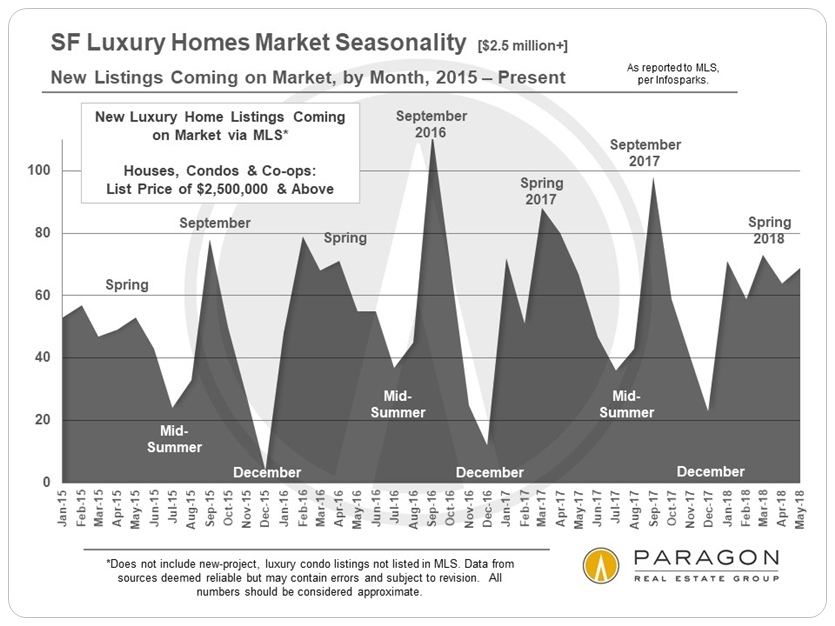
Luxury condo sales in San Francisco hit a new high in May 2018.
(Sales reported to MLS: new project sales would increase these numbers.)
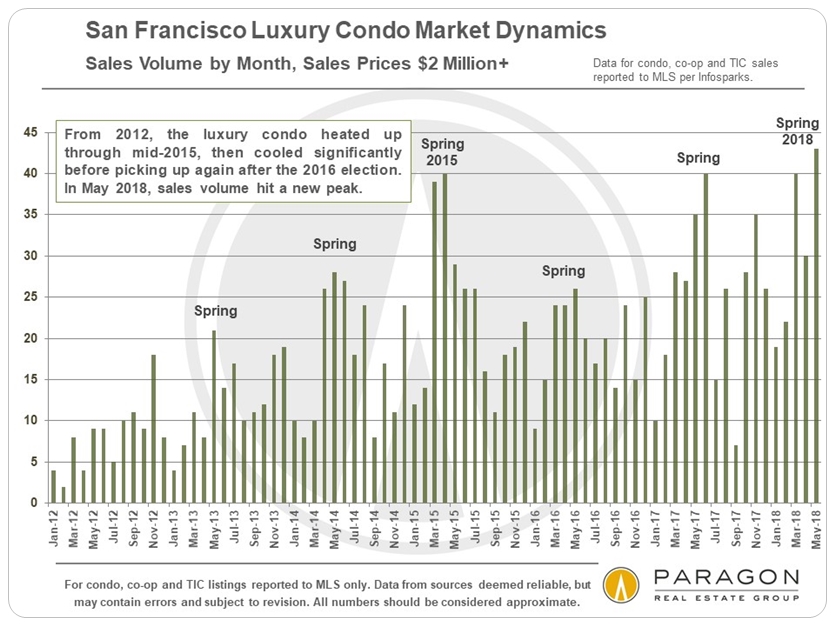
For the last few years, luxury house sales have more often peaked in October.
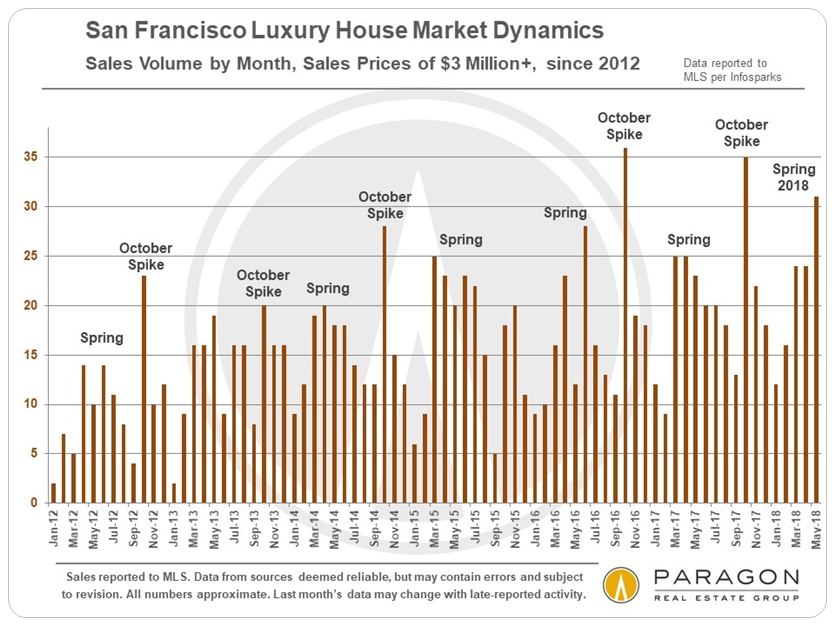
------------------------------------------------------------
Neighborhood Home Prices & Trends
Below are a few of the many new charts and tables from our updated report on neighborhood sales and values (What Costs How Much Where in San Francisco).
Home Price Tables by Bedroom Count
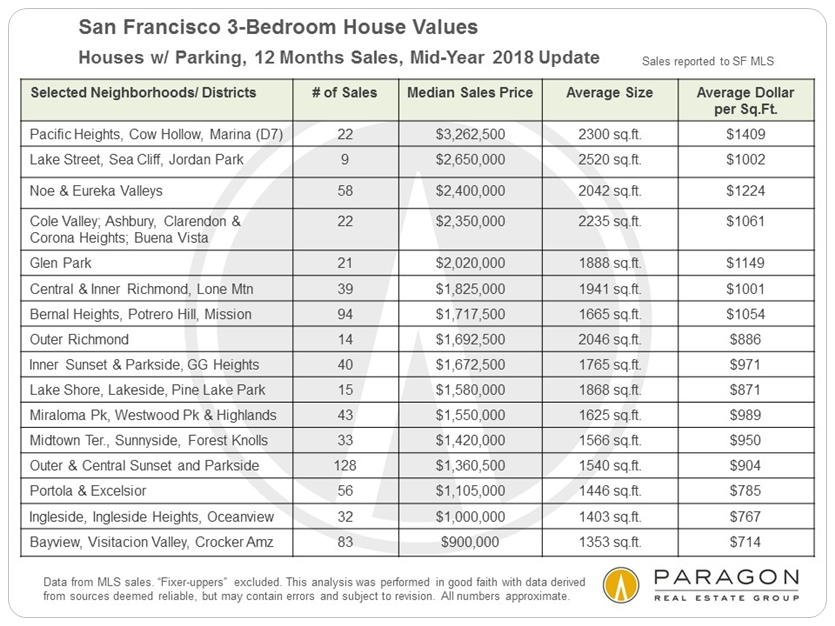
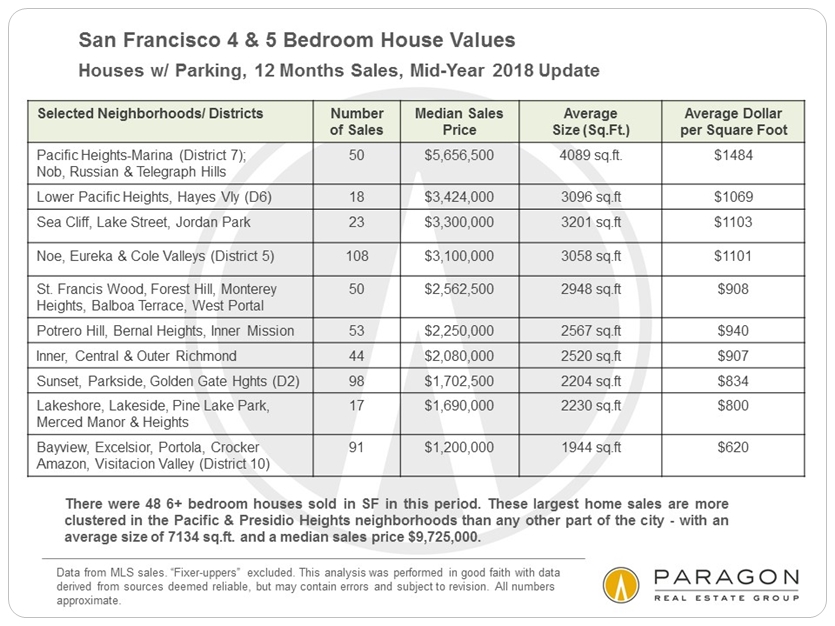
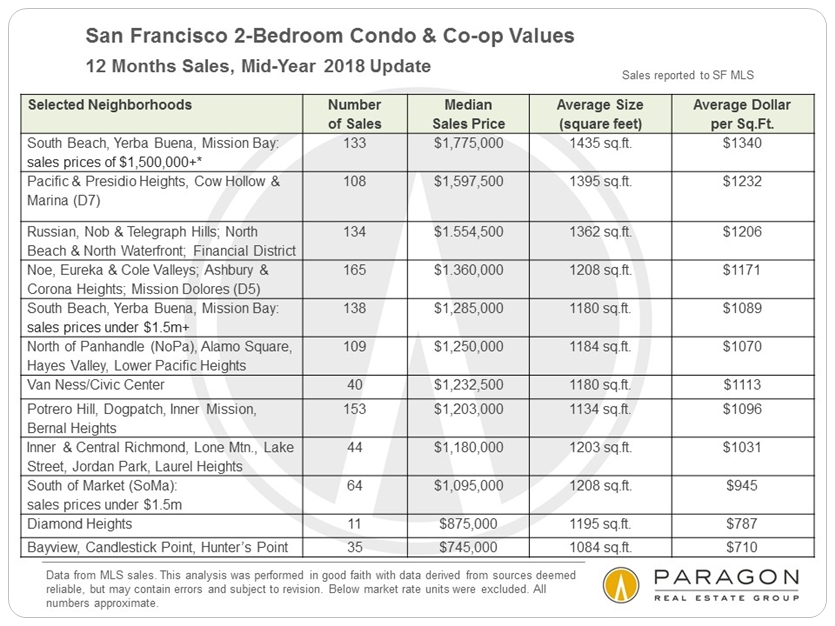
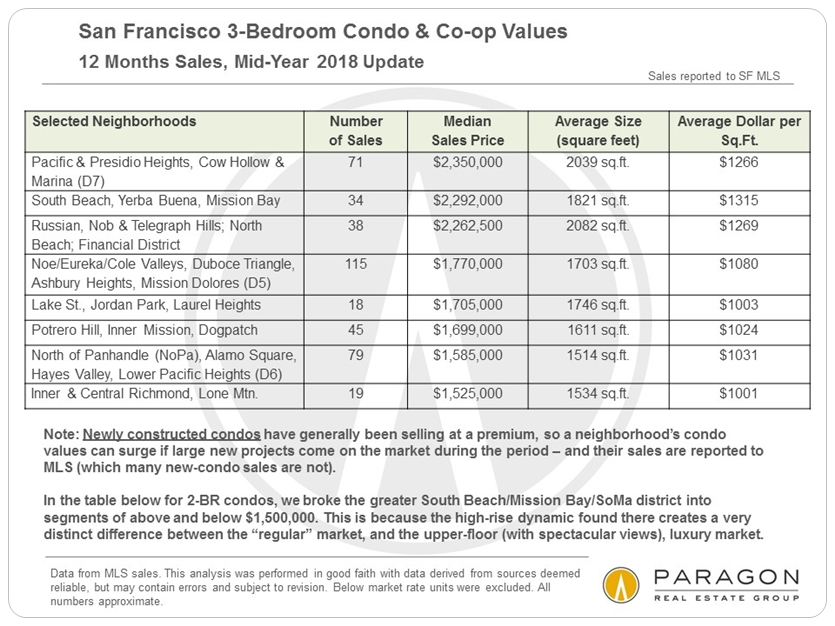
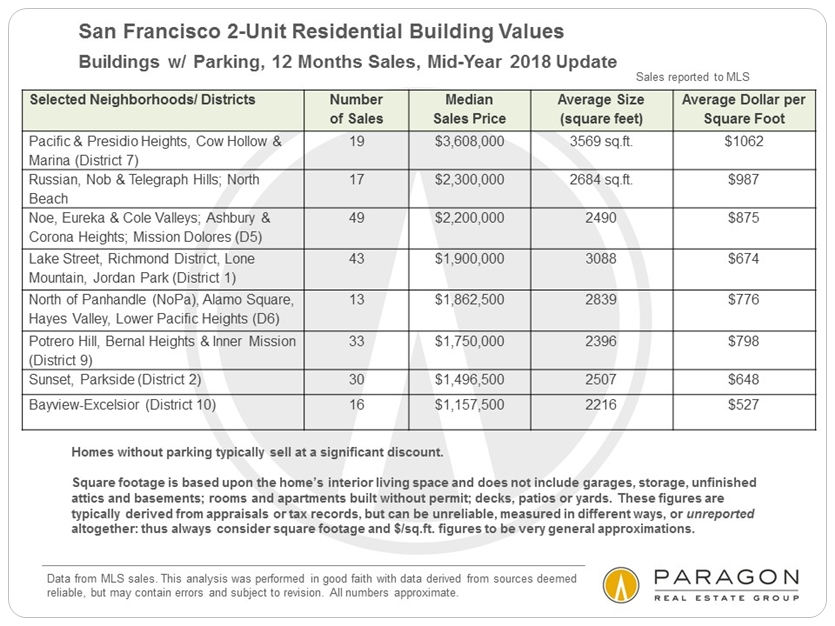
Where Best to Look in Your Price Range
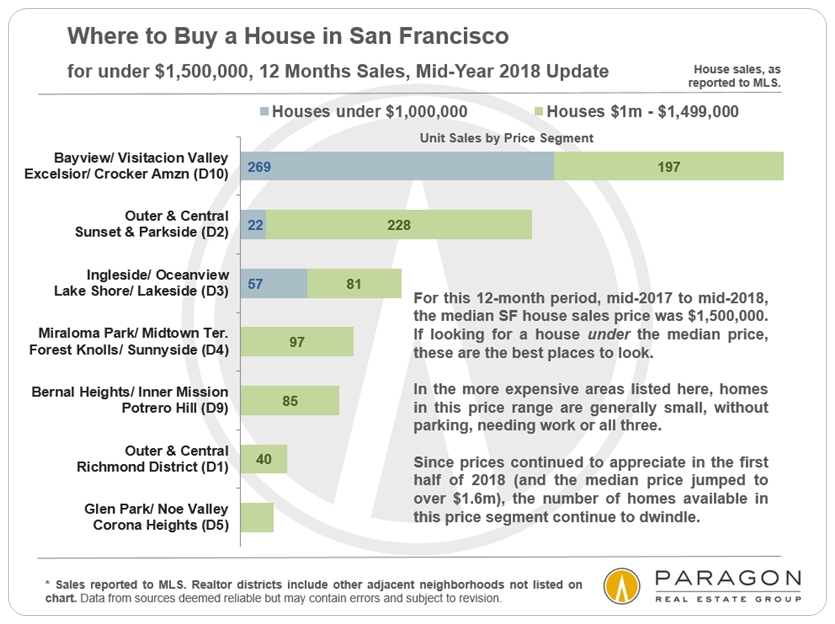
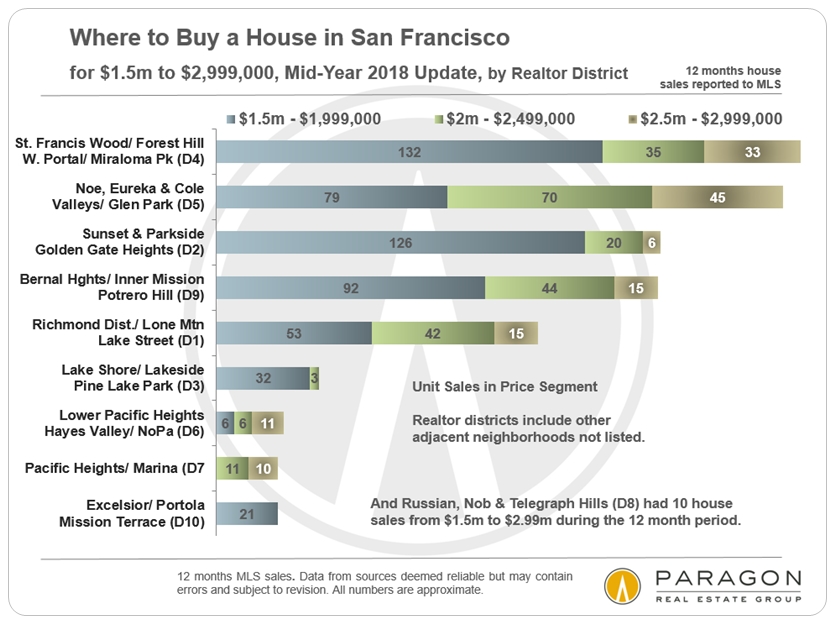
District Overview Appreciation Trends
Median sales price appreciation in the four biggest districts
for house sales by quantity of sales.
(Note: districts contain a multitude of neighborhoods.)
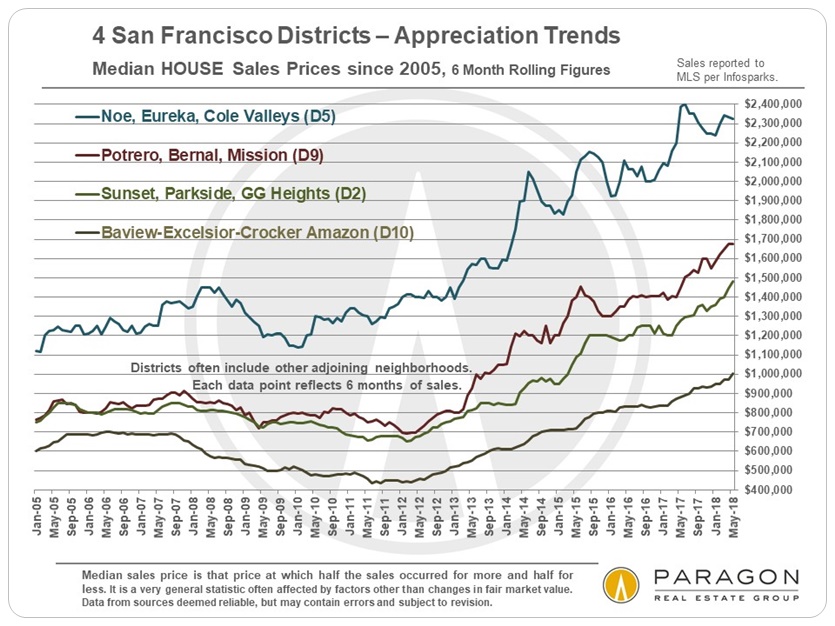
Median price appreciation for 2-bedroom condos and co-ops
in the 5 biggest condo-sales districts by number of sales.
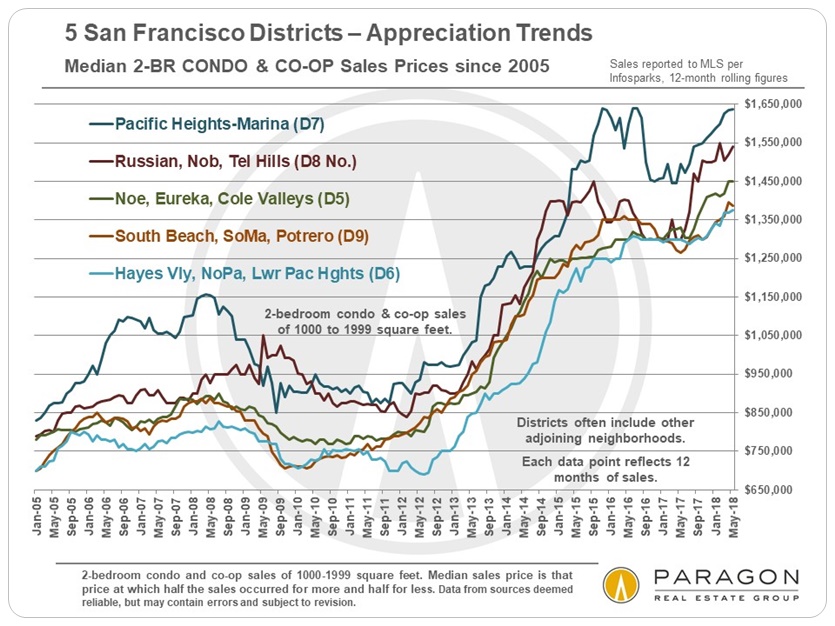
If you would like to see home prices or appreciation trends for a city district
or neighborhood not included above, please let us know. We cover them all.
------------------------------------------------------------
The San Francisco Building Boom
Approximately 68,000 housing units are now in the San Francisco new construction pipeline. Virtually all of them are apartments or condos: New house construction is minimal in the city, and has been so for over 50 years. Condos, new and resale, are now the dominant property type in market sales volume.
Just because a project is in the pipeline does not guarantee it will be built as planned. Plans are constantly being added, changed and abandoned. New housing construction is extremely sensitive to changes in economic conditions.
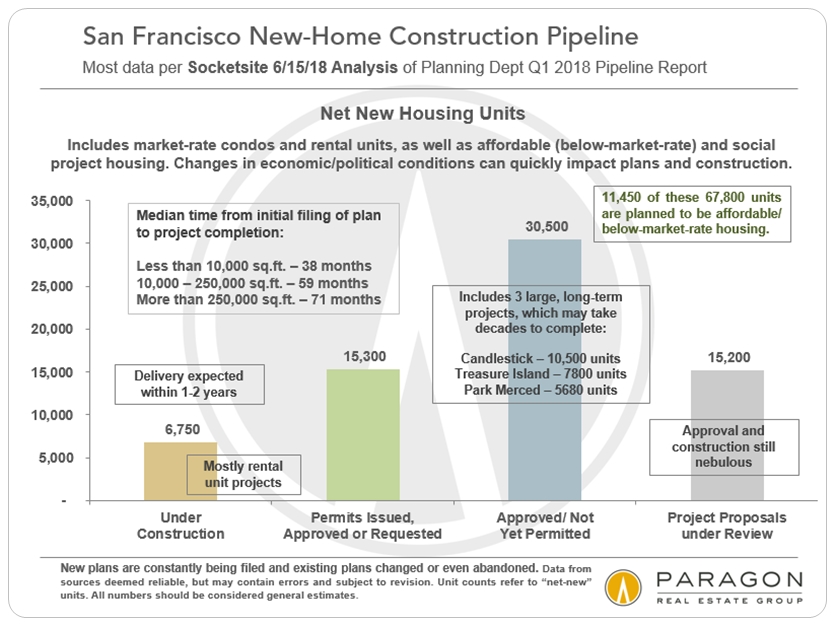
------------------------------------------------------------
------------------------------------------------------------
Annual Dollar Value Appreciation
Comparing the first half of 2018 to 2017, the median house sales price in San Francisco increased by an astounding $205,000 (per sales reported by 7/3/18). For condos, the increase was also very substantial, at about $71,000.


It is not a given that the second half of the year will see home price appreciation at similar rates: Prices could increase further, or they might plateau or even tick down instead. (As can be seen above, home prices can go down as well as up, though longer term trends have always been positive.) For the last 7 years, spring has typically been the most feverish selling season of the year and has often provided most of the appreciation occurring in the full year.


Median sales prices are often affected by other factors besides changes in fair
market value, such as changes in inventory, new home sales or luxury home sales.
------------------------------------------------------------
Market Dynamics Statistics
The decline in new listings, especially of houses, has been
a critical factor in the upward pressure on prices.

As houses have become the scarce resource in the San Francisco market,
overbidding percentages have gone into the stratosphere (though
strategic underpricing has also played a role).

New lows in average days-on-market since the 2012 recovery began:
Listings have been snapped up faster than at any time in the past 7 years.

Market activity typically starts slowing significantly in July
before spiking up again in the short autumn selling season.

------------------------------------------------------------
San Francisco Luxury Home Sales
as reported to MLS
The luxury home market is even more intensely seasonal
in its dynamics than the general market.

Luxury condo sales in San Francisco hit a new high in May 2018.
(Sales reported to MLS: new project sales would increase these numbers.)

For the last few years, luxury house sales have more often peaked in October.

------------------------------------------------------------
Neighborhood Home Prices & Trends
Home Price Tables by Bedroom Count
Where Best to Look in Your Price Range

District Overview Appreciation Trends
Median sales price appreciation in the four biggest districts
for house sales by quantity of sales.
(Note: districts contain a multitude of neighborhoods.)

Median price appreciation for 2-bedroom condos and co-ops
in the 5 biggest condo-sales districts by number of sales.

If you would like to see home prices or appreciation trends for a city district
or neighborhood not included above, please let us know. We cover them all.
------------------------------------------------------------
The San Francisco Building Boom
Just because a project is in the pipeline does not guarantee it will be built as planned. Plans are constantly being added, changed and abandoned. New housing construction is extremely sensitive to changes in economic conditions.

------------------------------------------------------------
It is impossible to know how median and average value statistics apply to any particular home without a specific, tailored, comparative market analysis. In real estate, the devil is always in the details.
Median sales prices may change as late-reported sales are entered into MLS. Typically, such changes are not material to the overall trends illustrated.
These analyses were made in good faith with data from sources deemed reliable, but may contain errors and are subject to revision. It is not our intent to convince you of a particular position, but to attempt to provide straightforward data and analysis, so you can make your own informed decisions. Median and average statistics are enormous generalities: There are hundreds of different markets in San Francisco and the Bay Area, each with its own unique dynamics. Median prices and average dollar per square foot values can be and often are affected by other factors besides changes in fair market value. Longer term trends are much more meaningful than short-term.
Median sales prices may change as late-reported sales are entered into MLS. Typically, such changes are not material to the overall trends illustrated.
These analyses were made in good faith with data from sources deemed reliable, but may contain errors and are subject to revision. It is not our intent to convince you of a particular position, but to attempt to provide straightforward data and analysis, so you can make your own informed decisions. Median and average statistics are enormous generalities: There are hundreds of different markets in San Francisco and the Bay Area, each with its own unique dynamics. Median prices and average dollar per square foot values can be and often are affected by other factors besides changes in fair market value. Longer term trends are much more meaningful than short-term.
